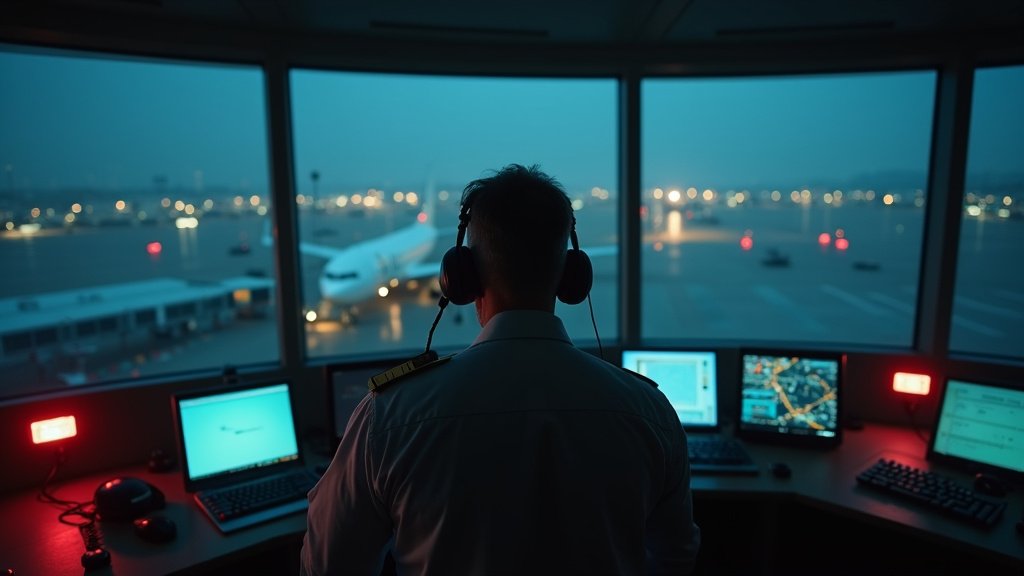The Air Traffic Control Crisis: Staffing Shortages Cripple LAX Operations Amid Federal Shutdown
A severe Air Traffic Control Crisis, fueled by critical staffing shortages within the air traffic control system, led to a temporary ground stop at Los Angeles International Airport (LAX) on Sunday morning, October 26, 2025, disrupting flights and stranding thousands of passengers. The incident, which began around 8:45 a.m. Pacific time and was lifted by 10:30 a.m., serves as a stark spotlight on the escalating Air Traffic Control Crisis within the nation’s air travel infrastructure, directly attributed to the ongoing federal government shutdown. This event underscores the fragility of critical services when federal employees are forced to work without pay, highlighting the depth of the Air Traffic Control Crisis.
LAX Flight Disruptions: Impact of the Air Traffic Control Crisis
The Federal Aviation Administration (FAA) initiated the ground stop, holding flights bound for LAX at their departure airports. The restriction primarily affected flights heading to Oakland and caused widespread delays across Southern California, a direct consequence of the Air Traffic Control Crisis. Passengers experienced average delays of approximately 49 minutes, with some facing wait times of up to 87 minutes. Even after the restriction was lifted, travelers were advised to closely monitor their flight statuses due to the residual effects of the disruption. This event at one of the world’s busiest airports highlights how quickly operations can be compromised by staffing issues, exacerbating the Air Traffic Control Crisis.
The Core Issue: Unpaid Air Traffic Controllers and the Air Traffic Control Crisis
The root cause of the ground stop at LAX, and numerous other disruptions nationwide, is the federal government shutdown, which has now stretched into its fourth week. Approximately 13,000 air traffic controllers, deemed essential workers, are required to continue their duties without receiving a paycheck. This unpaid labor is not only causing immense financial stress but is also leading to a significant increase in sick calls and absences, as controllers grapple with mounting personal expenses, deepening the Air Traffic Control Crisis. U.S. Secretary of Transportation Sean Duffy has repeatedly stated that controllers are “wearing thin” due to these circumstances, with a notable rise in missed workdays and contributing to the Air Traffic Control Crisis.
A Nationwide Phenomenon: Controllers Strained by the Air Traffic Control Crisis
The LAX incident is not an isolated event but rather a symptom of a larger, systemic problem affecting airports across the country, illustrating the pervasive Air Traffic Control Crisis. On Saturday alone, the FAA reported 22 “staffing triggers”—instances where staffing levels dipped below operational thresholds. These triggers have been observed at major hubs including Ronald Reagan Washington National Airport, Philadelphia International Airport, Chicago O’Hare, and Newark Liberty International Airport. Secretary Duffy noted that the figure of 22 triggers was “one of the highest that we’ve seen in the system” since the shutdown commenced on October 1, 2025, emphasizing the widespread nature of the controller fatigue and strain amid the Air Traffic Control Crisis.
Echoes of Past Disruptions and Pre-existing FAA Staffing Shortages Amid the Air Traffic Control Crisis
This recent disruption at LAX echoes earlier problems, such as the temporary unstaffing of the air traffic control tower at Hollywood Burbank Airport just weeks prior, a precursor to the current Air Traffic Control Crisis. That incident, occurring on October 6, 2025, led to significant flight delays and cancellations, with pilots needing to coordinate departures remotely. The current shutdown exacerbates an already critical shortage of air traffic controllers, as the FAA has been operating with approximately 3,500 fewer controllers than targeted levels, necessitating mandatory overtime and six-day work weeks even before the shutdown began. The shutdown has also halted training for new recruits, further compounding the long-term FAA staffing shortages and intensifying the Air Traffic Control Crisis.
Implications for Travelers and the Aviation System Amid the Air Traffic Control Crisis
The cascading effects of these air traffic control staffing shortages pose significant risks to the stability of air travel, contributing to the overall Air Traffic Control Crisis. Delays at one major airport, like LAX, can create ripple effects throughout the national network, impacting connecting flights and overall efficiency, a clear sign of aviation system strain. With the holiday travel season fast approaching, concerns are mounting that these air travel disruptions could intensify, leading to further cancellations and extended delays for millions of travelers. The economic impact is also considerable, with estimates suggesting the shutdown is costing the travel industry as much as $1 billion per week. The FAA’s operational capacity is directly tied to federal funding, and the ongoing deadlock in Congress creates uncertainty for the future of air safety and reliability during this Air Traffic Control Crisis.
This situation in Los Angeles serves as a critical reminder of the interconnectedness of government operations and essential public services, particularly in the face of a potential federal shutdown. The news from LAX today is a signal that without a swift resolution to the federal shutdown, the strain on air traffic controllers and the disruption to air travel are likely to worsen, solidifying the ongoing Air Traffic Control Crisis.





